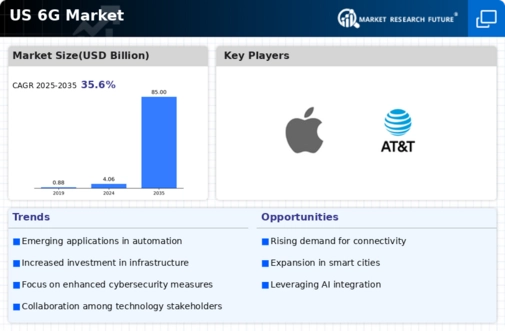Top Industry Leaders in the US 6G Market

Competitive Landscape of the US 6G Market: Paving the Way for a Hyperconnected Future
The 6G era promises to revolutionize connectivity, paving the way for unprecedented data speeds, near-instantaneous latency, and transformative applications across diverse industries. As the US positions itself as a leader in this burgeoning market, understanding the competitive landscape is crucial.
Key Players:
- Apple Inc.
- Nokia Corporation
- AT&T Inc.
- T-Mobile US, Inc.
- Verizon Communications Inc.
- Intel Corporation
- Huawei Technologies Co., Ltd.
- LG Corporation
- Cisco Systems, Inc.
- Sony Corporation
Strategies Adopted:
-
R&D Prowess: Leading players are pouring significant resources into 6G research and development, collaborating with universities, research institutions, and government agencies to expedite advancements.
-
Standardization Leadership: Companies are actively involved in shaping global 6G standards, vying for influence over future technologies and ensuring compatibility across diverse ecosystems.
-
Strategic Partnerships: Building strong partnerships with other players within the value chain is crucial for comprehensive offerings and efficient market penetration. Collaborations across infrastructure, software, and applications are key.
-
Early Infrastructure Deployment: Telecom giants are focusing on securing spectrum licenses and initiating pilot projects in select cities, aiming to establish themselves as first movers in the 6G landscape.
-
Vertical Market Penetration: Tailoring 6G solutions to specific industries like healthcare, manufacturing, and autonomous vehicles creates additional revenue streams and fosters adoption.
Factors for Market Share Analysis:
-
Technology Development: Companies with advanced 6G research and development capabilities, patents, and first-to-market solutions will gain an edge.
-
Infrastructure Footprint: Possession of existing network infrastructure and spectrum licenses provides a significant advantage for telecom companies.
-
Ecosystem Partnerships: Strong alliances with key players across the value chain – device manufacturers, software developers, and application providers – will drive market share.
-
Regulatory Landscape: Navigating the evolving regulatory environment related to spectrum allocation, security, and data privacy will be crucial for success.
-
Investment Levels: Sustained research and development funding, coupled with strategic acquisitions and talent recruitment, will enable companies to outpace competitors.
New and Emerging Companies:
-
Starlink and OneWeb: These satellite internet constellations potentially offer alternative network infrastructure for remote areas and could disrupt traditional terrestrial networks.
-
Edge Computing Companies: Businesses like Fastly and Cloudflare, specializing in edge computing solutions, are poised to benefit from the increased data processing demands of 6G.
-
Cybersecurity Providers: With heightened security concerns arising from hyper-connected devices and networks, companies like Palo Alto Networks and Fortinet are expected to play a critical role in securing the 6G ecosystem.
Current Company Investment Trends:
-
Focus on Terahertz Spectrum: Research and development efforts are concentrated on unlocking the potential of terahertz frequencies for ultra-high data speeds and low latency.
-
AI-powered Network Management: Integration of artificial intelligence and machine learning is crucial for optimizing network performance, automating tasks, and ensuring efficient 6G operations.
-
Emerging Applications: Investments are directed towards developing diverse applications leveraging 6G capabilities, including immersive AR/VR experiences, connected autonomous systems, and real-time remote healthcare.
Latest Company Updates:
- November 15, 2023: The Next Generation Mobile Networks Alliance (NGMN) released a white paper outlining the potential applications and challenges of 6G. The paper highlights areas like AI-powered networks, holographic communication, and extreme connectivity for autonomous vehicles.
- December 12, 2023: Qualcomm announced a partnership with Samsung to develop 6G chipsets, aiming for commercial deployment by 2030.
- January 18, 2024: The US Department of Commerce hosted a workshop on 6G security, highlighting the need for international collaboration to ensure secure and reliable next-generation networks.

